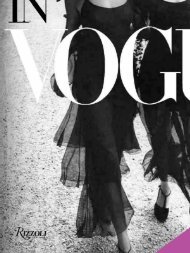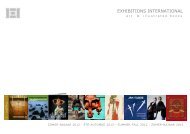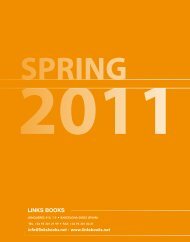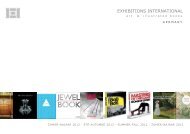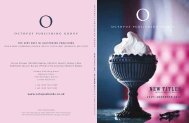DYNAMIC IDENTITIES How to create a living brand
DYNAMIC IDENTITIES How to create a living brand
DYNAMIC IDENTITIES How to create a living brand
You also want an ePaper? Increase the reach of your titles
YUMPU automatically turns print PDFs into web optimized ePapers that Google loves.
Aol. wallpaper (pg 40)<br />
by Wolff Olins, 2009<br />
DNA of the IDTV identity (pg 54)<br />
by Lava, 2007<br />
type of dynamic identity for Aol. Behind the<br />
wordmark ‘Aol.’, a space is <strong>create</strong>d that forms<br />
a platform for artists. Each time, different<br />
artwork is selected from a moni<strong>to</strong>red data<br />
bank of images <strong>create</strong>d by artists around the<br />
world. Visi<strong>to</strong>rs of the website can even select<br />
their favourite <strong>to</strong> use.<br />
It does not necessarily have <strong>to</strong> be the<br />
ingredients, such as the four black and white<br />
pixels that form the DNA of IDTV, that form<br />
the identity. It could also be a set of rules,<br />
a formula. Back in 1998, the Google Doodles<br />
were <strong>create</strong>d when Google founders Larry<br />
and Sergey played with the corporate logo <strong>to</strong><br />
indicate their attendance at the Burning Man<br />
Festival. The identity formula – a set of colours<br />
in a particular order and a vague shape of the<br />
wordmark – still stands, daily commemorating<br />
interesting events and anniversaries. In a<br />
similar fashion, New York’s New Museum could<br />
communicate their different exhibitions and<br />
events each day due <strong>to</strong> its system of leaving<br />
a space between ‘New’ and ‘Museum’ that<br />
can be filled in endlessly. The formula could<br />
also be a fixed language in combination with<br />
set typography and colour. Take the Nikolaj<br />
Kunsthal, for example, a Danish art centre<br />
which Scandinavian Designlab personified and<br />
gave it a language/<strong>to</strong>ne <strong>to</strong> speak in. Because it<br />
is located in a former church, they let it preache<br />
its passion for art through biblical quotes:<br />
“Let there be art” and “May art be with you”.<br />
Predetermined input leads <strong>to</strong> controlled<br />
output. Opening up one of the components<br />
and letting it be influenced by external<br />
input can lead <strong>to</strong> more <strong>living</strong> results. Take<br />
for example the OCAD University, where the<br />
identity holds actual student art and design.<br />
The logo literally becomes the display<br />
window for the students, cus<strong>to</strong>mised <strong>to</strong> the<br />
graduating student medal winners ach year.<br />
A much less controlled and much more<br />
recent technique is the generative approach.<br />
The identity of the Scandinavian peninsula<br />
Nordkyn designed by Neue, for example,<br />
uses real-time data coming from a weather<br />
station <strong>to</strong> build their identity. For the identity<br />
of the Japanese television station TV Asahi,<br />
Toma<strong>to</strong> had let the identity be reactive <strong>to</strong><br />
The Google Doodle formula<br />
by mwmgraphics, 1998<br />
sounds recorded at a certain location. Both<br />
these ‘generative’ identities are <strong>create</strong>d with<br />
scripted <strong>to</strong>ols, a gift of modern technology.<br />
When using real-time data <strong>to</strong> feed a number<br />
of parameters, artwork is generated that<br />
forms the identity. It is basically a technical<br />
<strong>to</strong>ol: once programmed, the computer does<br />
the work. This may feel like a trick, but it is<br />
one that can be performed in many different<br />
ways. When the input is generated by live<br />
information, the identity reflects the world<br />
it is <strong>living</strong> in and adapts according <strong>to</strong> its<br />
real-time input. It becomes alive.<br />
Possibilities for this input are numerous: time,<br />
the activity on a site or in a building, live tweets,<br />
s<strong>to</strong>ck information, the news, the number of<br />
visi<strong>to</strong>rs <strong>to</strong> a museum, anything really. The less<br />
controlled the input, the more alive the identity,<br />
keeping in mind that there should always be a<br />
constant that makes the identity recognisable.<br />
Losing <strong>to</strong>uch is a danger inherent <strong>to</strong> dynamic<br />
identities, so avoiding that pitfall should be a<br />
priority for the designer. The trick is <strong>to</strong> <strong>create</strong><br />
as much room for dynamism as possible,<br />
while maintaining recognition.


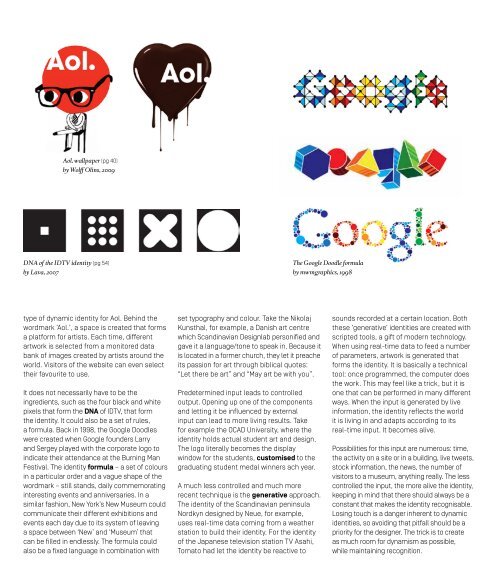
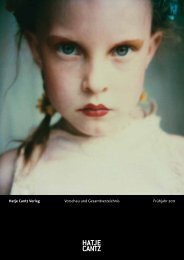
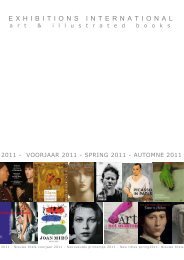

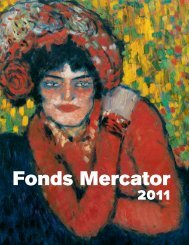
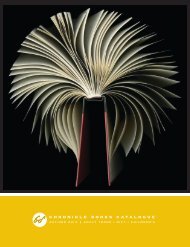
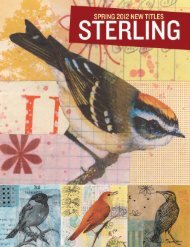
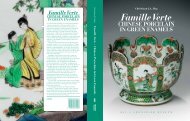
![01 -[BE/INT-2] 2 KOL +UITGEV+ - exhibitions international](https://img.yumpu.com/19621858/1/184x260/01-be-int-2-2-kol-uitgev-exhibitions-international.jpg?quality=85)

